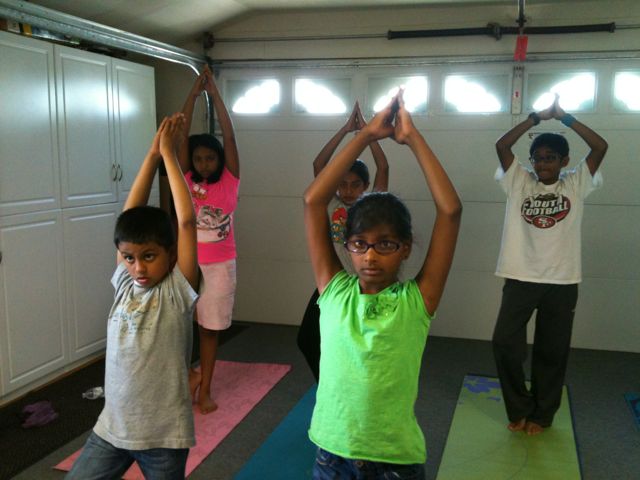What did you learn today? NOTHING. Common answer. Hence the report - Just ONE DAY REPORT. You can imagine.
Yoga class - High energy youth teaching the high energy kids - fun to see the synergy; parent volunteers stayed outside because they did not want to disturb this synergy. Aria and Suchit kept the group on their toes. Towards the end, when they indeed burnt out their energy, Ashwini conducted a bhramari based meditation technique. The silence they followed was amazingly beautiful. We learnt two terms - Mouna - Sanskrit term for silence and Muni - the Sanskrit term for a yogi who is silent.
Snack time - Organic grapes and organic carrots; organic bread and organic peanut butter; Ritz crackers; Orange or Apple juice; Suchit did a beautiful session of icebreaker with them.
Gita chanting - We learned Sahanavavatu - the peace chant we do before the yoga class and the first shloka of Bhagavad Gita chapter 16. We talked about the context in which Krishna teaches Gita to Arjuna. We chanted the first shloka many times, sometimes very slow, sometimes very fast, sometimes breaking the sentence, sometimes the entire quarter part of shloka, etc, just to give them fun time with learning. A minute of silence after Gita chanting was the most exhilarating experience for all the adults and kids. They indeed looked like Muni to us.
Philosophy - We discussed the theme of 16th chapter - the Daivi Sampath and Asuri Sampath. Some kids knew this - thanks parents. God's wealth - what is it? Is it gold/silver/diamonds? They said, no the good values ! We discussed that they can acquire the wealth of divinity by following good values. We learned the words - Abhaya - Fearlessness; Satva - Balance in life; Samshuddhi - Purity of character; dana - charity (answered by Vivek); dama - self control ; yajna - sacrifice (sharing); tapa - hard work; Jnanayoga - one kid answered - Knowledge about yoga :-) and we took it for now! So we will be working on all these values through the camp.
We discussed Karma Yoga - where they learn in school with all passion, but never worry about the grades; there was a debate on this amongst the kids; How can we motivate to do well without worrying about the grades? We cannot plan to study without worrying about our grades. We answered saying - worry is taking the time off of planning and studying;
- We have 10 mins; should we study or worry? - the answer was study
- We have 10 mins; should we study 10 mins or study for 9 mins and worry for 1 min or study all 10 mins? - study all 10 mins?
- So for a person who is busy working hard, where is the need or time for worry? They got the point. But not completely. So parents, do bring this up as they are quite bent upon grades, grades and grades. That will be nothing but stress, stress and stress in middle/high school.
Story session - one session for big kid group (over 10) and one for small (9 and below). They listened to the story with the theme - Satya - Patanjali's first Yama. The discussions are simply amazing! Cannot elaborate everything.
Nature and Me - We planted the seeds in a pot. We will keep watering them everyday.
Second half
We had lunch with Suchit pulling their legs, telling them weird stories about his cooking skills (or the lack thereof :-) The kids were simply having fun pulling his legs.
We had a DRT session led by Reshma. They almost felt asleep and this is actually a much needed siesta style relaxation for them. Philosophy behind this is though they say it was boring, but, we teach them to relax and even take slowness of life. Boredom is a part of life. Life is not a roller coaster ride and our children are too stimulated to understand slowness. So boredom is a symptom of restlessness and we are teaching them to relax.
Art work - Theme - Environment - We taught them to use less resources, less disposables, less napkins in the toilet, bring their own napkins and lunch cover that they can use to eat lunch on. We want to come into the nature and leave it as if we never touched it. Like a fish entering the lake, not a buffalo entering the lake. Basically, we said to leave the place as it was when they entered, be it environment, kitchen, yoga place or this universe. They were asked to draw a picture art and write the words - I came, I saw and I left it as it was - A quote inspired by Amitav, the child who attends the camp. Originally said by Julius Caesar as I came, I saw, I conquered.
Mahabharata - We are watching Mahabharata selected episodes, not fully, but pieces. I discuss the story as they watch. We watched Bharata the son of Dushyanta Shakuntala choosing Bharadwaj as his heir instead of his sons. We discussed what sage Kanva says to Bharata - Conquer yourself O King, who has conquered the world. They quickly knew what conquering oneself means. Please discuss this with your kids. We watched Bhishma's (Devvrat)'s bravery episode, all for about 30 mins - just selected pieces, skipping the lengthy romantic pieces, that does not concern children.
Games - We played Kabbadi - a strategy based modified kabbadi and you should watch them to see how they learn to strategize. Cannot explain it. But they were excited to learn. Then we played human chess - another game of strategy.
Advanced Yoga - We did Shirshasana using our prop. We practiced Vrikshasana and Nataraja pose and competed on who stands still the most. Amitav could stand with eyes closed on one leg. Quite a feat.
OM Meditation - We chanted 9 rounds of Aum and ended with Savre Bhavantu Sukhinah chant.



